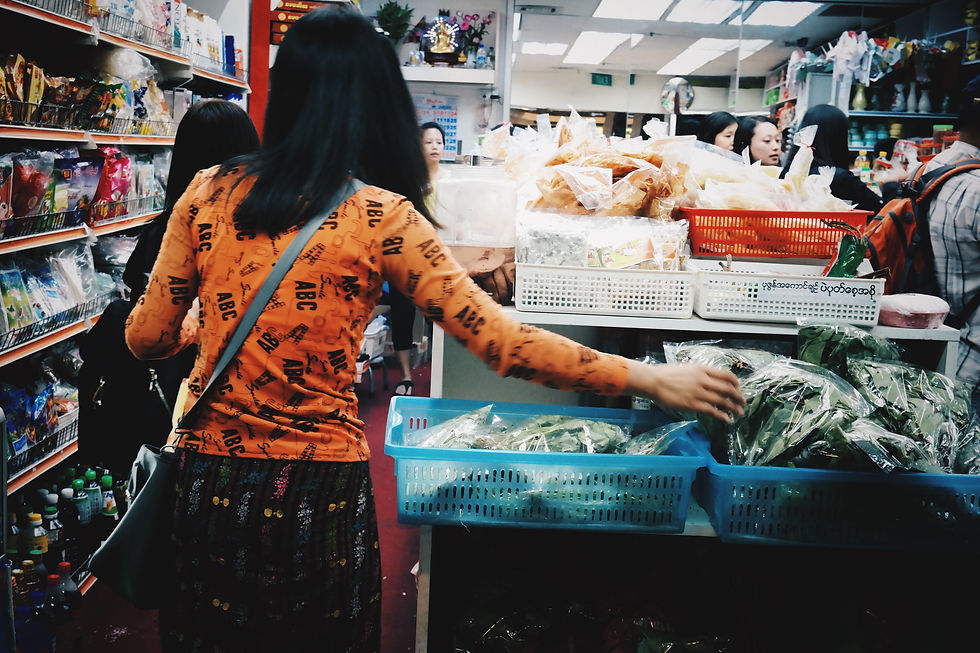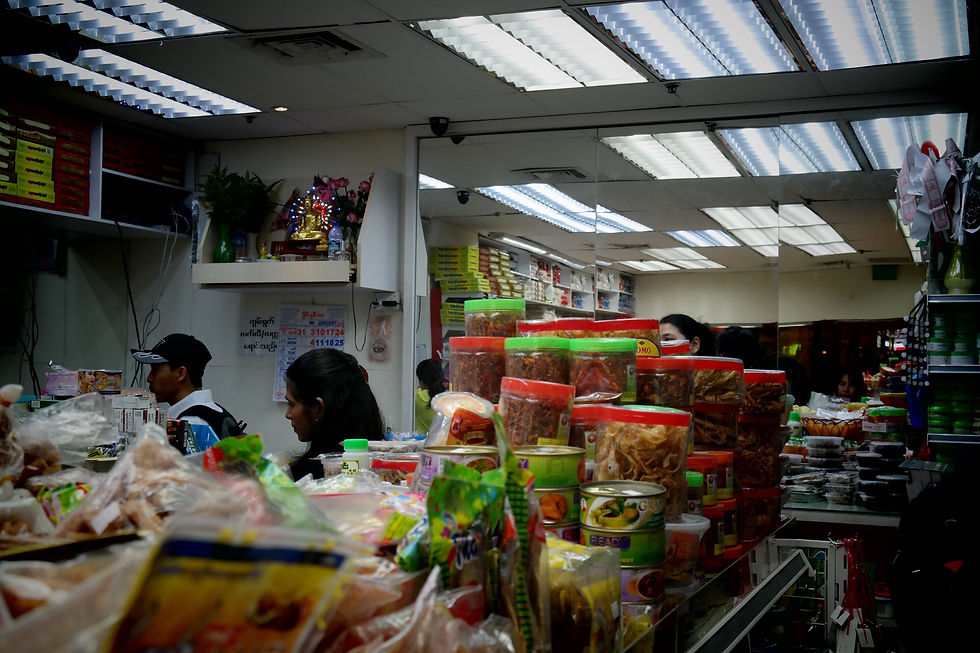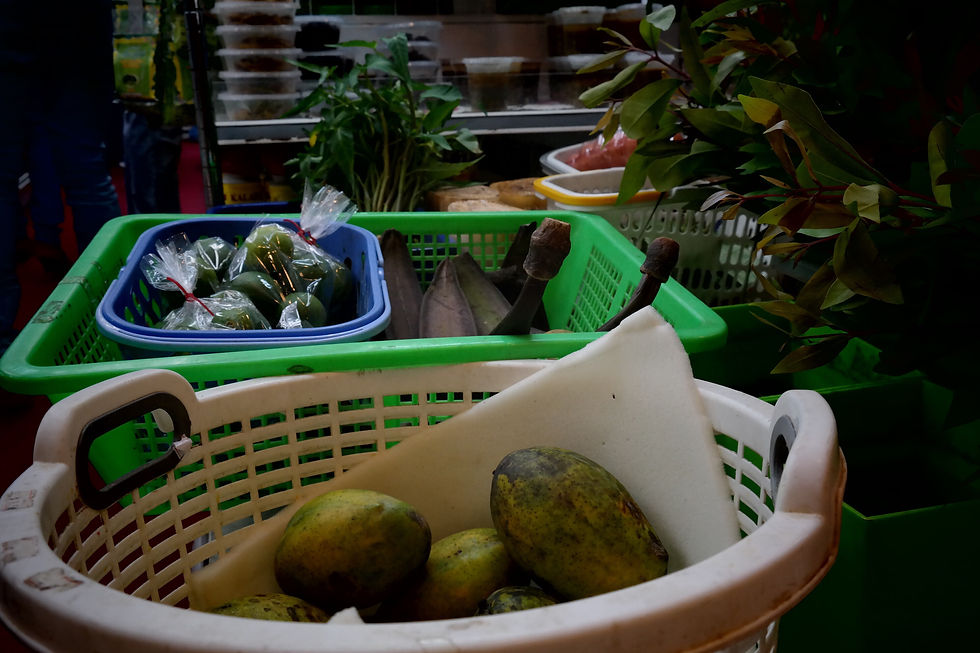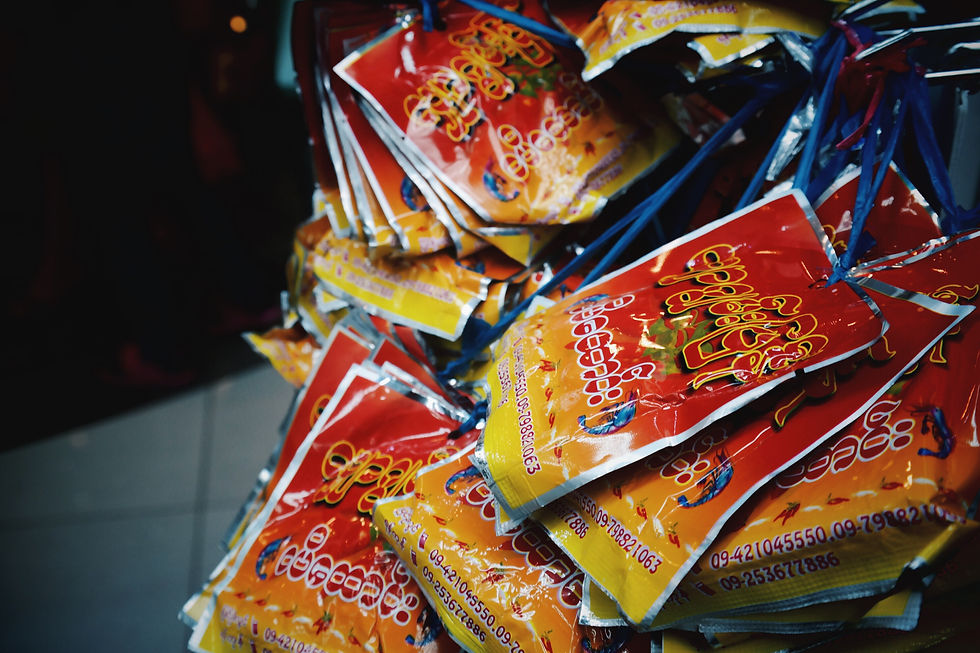Peninsula Plaza | Food & Identity
- Group
- Oct 21, 2016
- 6 min read
On the 14th October, our group set out to discover more about Burmese cuisine, that was until now, largely unfamiliar to us. Here's a brief introduction of Peninsula Plaza before we get into the delicious stuff:
Peninsula Plaza was first built in 1980, as a commercial property serving retail, rental, sale and other commercial functions. It is a skyscraper of about 381 feet tall and 30 floors above the ground. More interestingly, it is also intimately known as the "Little Burma" of Singapore. With travel agencies, visa agencies, money changers, souvenir shops and traditional Burmese food stores and markets, Peninsula Plaza is the place to be for a feel of Burma. Indeed, going there on a Sunday left us in amazement at the number of Burmese people present, as well as its the colourful and vibrant vibes.
Back to our food tasting experience, we explored Peninsula Plaza in search of Burmese foods as well as local Burmese who were willing to share their experience regarding the importance of Burmese food in their culture. We embarked on this little journey without any expectations, only with excitement.
Food Tasting Experience
We begun our food journey in an eatery that served Burmese Chinese cuisine. On a first look, the stall's set-up and dishes completely resembled the Chinese 'Cai Png' - an array of Chinese dishes to choose from accompanied with rice. We bought two plates of food to share and discovered that the tastes and texture of the dishes were quite different from what we were used to. Part of the dish reflected strong Asian tastes and used spices and ingredients that are popular in the South East Asia region. For instance, spinach in the dish (refer to Image A) was cooked simply with salt and garlic and is of not much difference from the dishes we usually cook at home. On the other hand, the fish cake served was slightly different from the usual texture of the fish cake we get in Singaporean Chinese cuisine. It was deep fried and slightly tougher, making it difficult to chew past the skin. Next, there were differences in the rice - a common Chinese staple food. The rice we tried was drier than the usual soft Chinese rice that some of us are used to. Rather, it was more similar to long-grained, dry rice used commonly in the Indian cuisine, Nasi Briyani. This fusion and similarity of textures between the Burmese cuisine and those found in other cuisines were an interesting observation.

Image A: A Burmese dish that resembles our local Chinese "cai png"
Apart from the above mentioned, it was the soup that came with the rice set that struck the biggest difference between the Burmese cuisine and that of the Chinese. The soup was intensely sour and we found it difficult to finish. Upon further research, we also discovered that the Burmese appreciate the taste of sourness and saltiness over the Chinese people's preference of sweet and spicy. What is most interesting is the fact that while we may all be of Chinese descent(Burmese Chinese/Singaporean Chinese), being born and raised in different places have made our cuisines different, both in the way prepared as well as the tastes and looks. And the fact that we are able to taste different types of Chinese cuisines, thanks to migrant communities such as that of the Burmese in Singapore further accentuates the notion of a Chinese diaspora, or simply, the movement of people throughout the world.
For the second dish (refer to Image B), it was a simple meal consisting of okra (a.k.a lady's finger) and fish cake. Because of the commonality of the lady's finger in Singaporean Malay cuisine, we naturally compared what we ate to that of the Malay style of cooking. This dish of lady's finger differed in the sense that it was cooked simply without any additional ingredients such as eggs. It was also seasoned only with salt, and then stir-fried. Another noticeable contrast between Burmese and Singaporean Malay/Chinese dishes is the nature of the gravy that accompanied them. For instance, that of the Burmese dishes appear to be more 'soupy' in terms of density while that of the Malay/Chinese ones are usually thicker and oiler. The former also boosts a spicier taste while that of the former are distinctly saltier or sweeter.

Image B: Okra and fish cake dish
Upon further research, we gathered that Burmese food is quite a distinct and unique cuisine. With Burma located amongst China, India and Thailand, the influences on their cuisine are a mixture of all these different countries. Burma cuisine is broadly categorised into two different types, namely from the 'Upper Burma' and 'Lower Burma'. Dishes from Upper Burma tend to use more beans and sesame, while those from Lower Burma tend to use more fish paste and are usually more sour-tasting. This result of the latter bears more similarities to Thai cuisine and could be due to the proximity of both countries.
Speaking with the Burmese people
After our food tasting experience, we sought out locals willing to share with us more information about food and culture of Burma. Despite initial rejections, we managed to find a Burmese man [refer to image C] perched on a stool at the back of a convenience store with a spread of dishes laid out in front of him. While he refused to be named, according to him, the store that he was at belonged to a friend of his who happened to be away. He smilingly mentioned that this friend of his and his wife would often invite him over for a meal if they happened to prepare Burmese cuisine. While his work place was not near to Peninsula Plaza and he did not frequent the mall (unlike most other Burmese migrants), he would be sure to come by if his friends had prepared Burmese dishes for him.
This account succinctly shows the power of food at bringing people together, even when it is literally out of the way sometimes. After all, everyone just wants a piece of home, as much as possible, being away from families and friends. A genuine friendship or a connection formed in a foreign place such as Singapore proves more intimate and important than any other things.

Image C: Burmese man we managed to chat with
Markets in Peninsula Plaza
As we toured around the different levels in Peninsula Plaza, we came to find many small markets ran by Burmese, for Burmese. Within these stores, were plentiful Burmese food products, from snacks and drinks to fresh cooking ingredients and sauces. Because of the rather close proximity of Singapore and Burma (considering that the flight does not take more than a few hours), we would think that authenticity in Burmese food making here is not a big issue. After all, specific sauces needed for certain Burmese dishes could be imported, and they could also be sold in Burmese mini-marts that we saw.
While we would not doubt that some Burmese dishes would have been altered perhaps for the sake of convenience, the change would not be tremendous because Asian sauces, especially Chinese sauces, tended to be quite similar in many ways. This means that authenticity of Burmese cuisine here in Singapore is retained to a great extent. Of course, as we have only tried the Burmese 'Cai Png', we can only speak for the Burmese Chinese cuisine. It is also important to note that there are many other ethnicities in Burma.




Furthermore, since Peninsula Plaza has become the heartland of the Burmese community here in Singapore, we feel that the food sold here would be as close to authentic Burmese food as it can get because it would have to appeal to the Burmese population here.
Conclusion
As we peek into the different facets of a migrant life, food becomes not only an essential thing to life, but also a representation of one's identity and culture. Being away from home, for whatever reasons and under whatever circumstances, is not an easy task. Yet here in Peninsula Plaza, we see faces of smiles and sounds of laughter on these Burmese people, while they congregate to converse in Burmese over a simple but heartily prepared meal with their fellow people. It is without a doubt that food brings people together, and for the Burmese here in Singapore, it is an reinforcement of their culture and identity, as well as a familiar link back home.
References:
https://www.peninsulaplaza.com.sg/
Comments